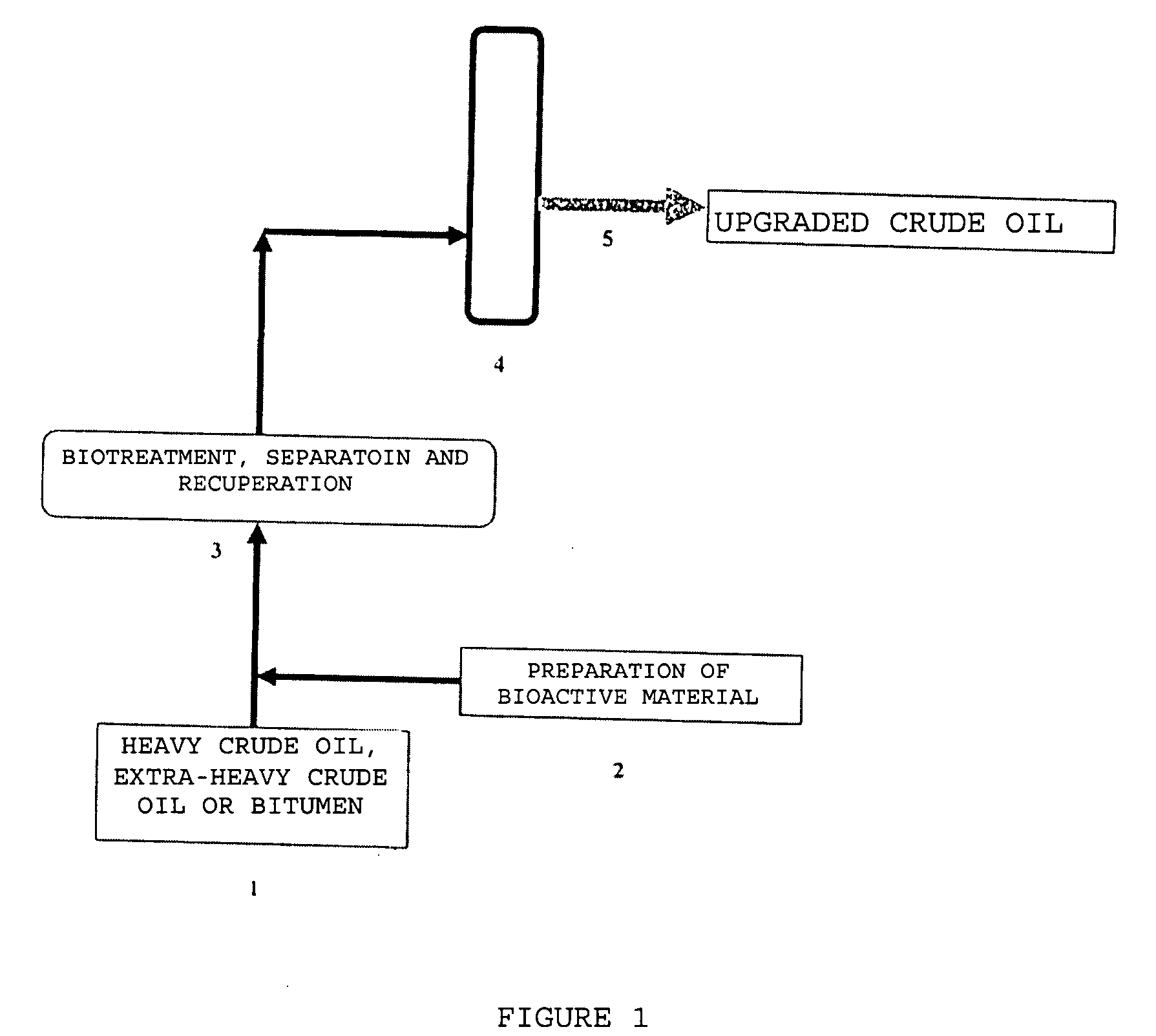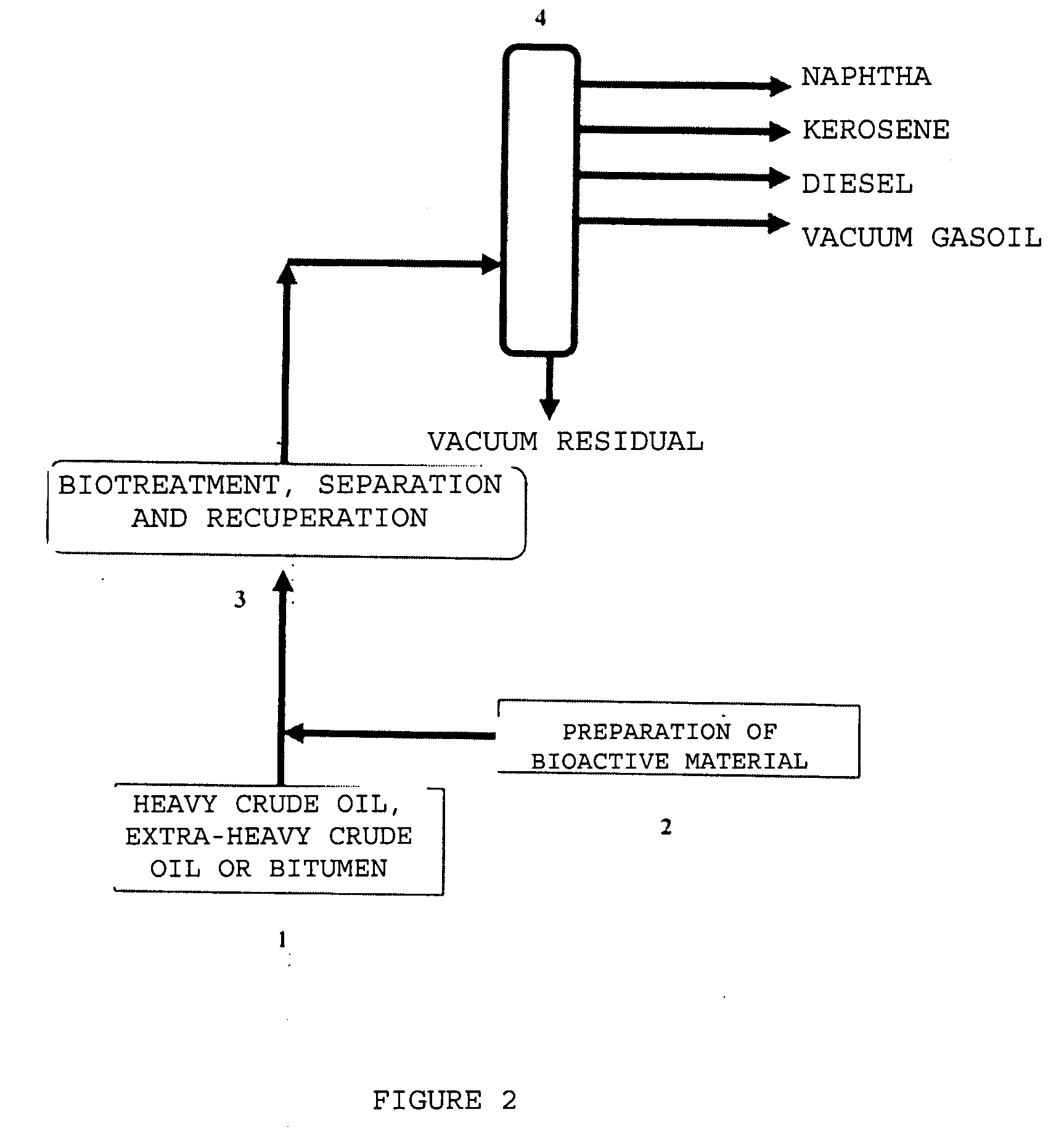Process for the upgrading of heavy crude oil, extra-heavy crude oil or bitumens through the addition of a biocatalyst
a biocatalyst and heavy crude oil technology, applied in the direction of biosynthesis, fermentation, etc., can solve the problems of low conversion rate and/or a high percentage of waste products, and the problem of transport, handling and disposal of wastes
- Summary
- Abstract
- Description
- Claims
- Application Information
AI Technical Summary
Benefits of technology
Problems solved by technology
Method used
Image
Examples
example 1
[0043]In this example, as indicated in Table 4, the advantages of this invention are illustrated when the distillates obtained by coking of the control Cerro Negro extra-heavy crude oil are compared with those obtained from the crude oil biotreated through the process of this invention.
TABLE 4Distillates of theDistillates of thecontrol Cerrobiotreated crudeNegro crude°API2924Sulfur (% wt)2.993.22Nitrogen (%)0.260.29
[0044]This example corresponds to the process with the bacteria No. CVCM 1774. Both the biotreatment flask and that of control, without the biocatalyst agent, were incubated in an orbital shaker at 30° C. and 200 rpm. Samples of 20 ml were collected at various fermentation times (16, 24 and 72 hours). The emulsion was broken at 90-100° C., the recovered crude oil was washed with distilled water and then they were both subjected to coking.
example 2
[0045]This example, as Table 5 indicates, illustrates the process of this invention executed with the Consortium of degrading authocthonous bacterial strains of extra-heavy crude oil No. CVCN 1776, 1777, 1774, 1752 and 1753. Both the biotreatment flask and that of the control, without the biocatalyst agent, were incubated in an orbital shaker at 30° C. and 200 rpm. Samples of 20 ml were collected at various fermentation times (16, 24 and 72 hours). The emulsion was broken at 90-100° C., the recovered crude oil was washed with distilled water and then they were both subjected to coking.
TABLE 5Distillates of theDistillates of thecontrol Cerrobiotreated crudeNegro crude°API3624Sulfur (% wt)2.993.22Nitrogen (%)0.260.29
[0046]This example, as indicated in Table 6, illustrates the advantages of the process of this invention executed with the enzymatic extract of the consortium described in example 2, through the simulated distillation of the crude oils obtained.
TABLE 6Distillation (%Cerro ...
example 4
[0049]This example, as indicated in Table 7, illustrates the advantages of the process of this invention using the fungus No. CVCM 1784, through the simulated distillation of the crude oils obtained.
TABLE 7Cerro NegroBiotreated crudeControl crude (%Distillation(% wt)wt)Naphtha, IBP-200° C.1.411.08Jet, 200–250° C.2.132.23Diesel, 250–350° C.14.468.80GOV, 350–500° C.28.5428.63RV, 500° C.+ (% wt)53.4660.34
[0050]Both the biotreatment flask and that of the control (without the biocatalyst agent) were incubated at 30° C. and 250 rpm and samples were taken at 24, 48, 72, 96 and 120 hours of fermentation. Then, the emulsion was broken at 90-100° C., the recovered crude oil was washed with distilled water and then they were both subjected to a thermal process at 350° C. for one hour.
[0051]As shown, the advantages of this invention are evident on the basis of the excellent conversion of the fraction of residual 500° C.+, and the corresponding high performance of upgraded light hydrocarbons.
PUM
 Login to View More
Login to View More Abstract
Description
Claims
Application Information
 Login to View More
Login to View More - R&D
- Intellectual Property
- Life Sciences
- Materials
- Tech Scout
- Unparalleled Data Quality
- Higher Quality Content
- 60% Fewer Hallucinations
Browse by: Latest US Patents, China's latest patents, Technical Efficacy Thesaurus, Application Domain, Technology Topic, Popular Technical Reports.
© 2025 PatSnap. All rights reserved.Legal|Privacy policy|Modern Slavery Act Transparency Statement|Sitemap|About US| Contact US: help@patsnap.com


